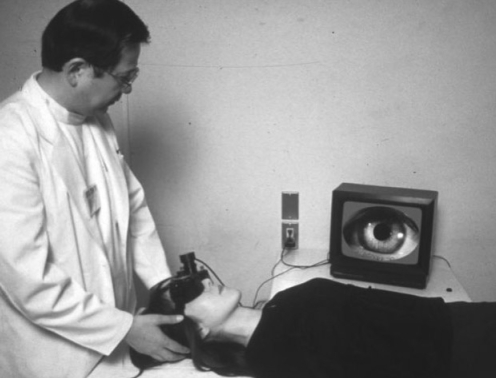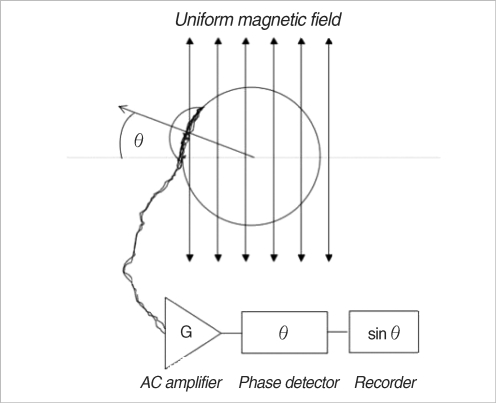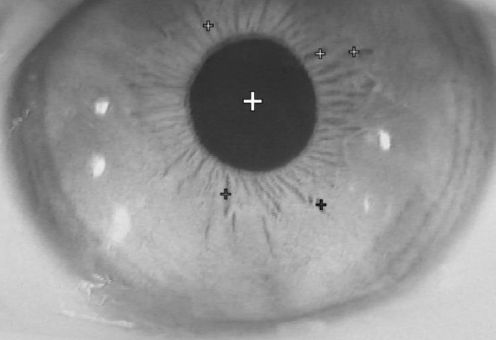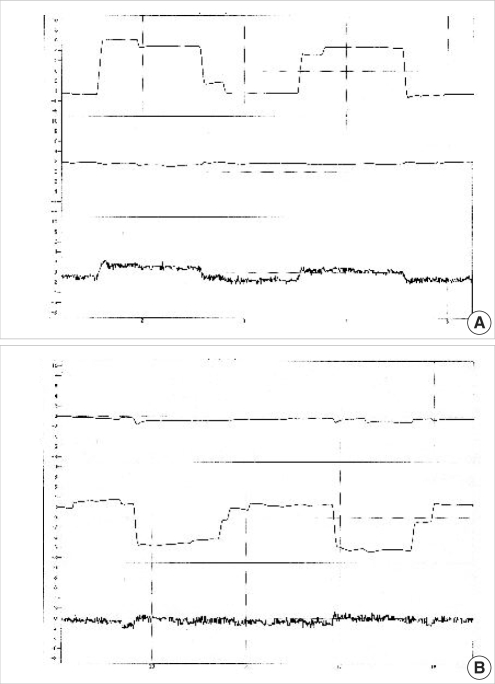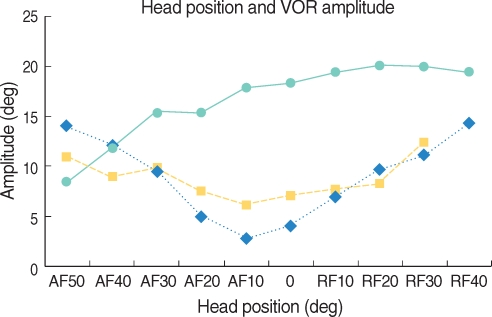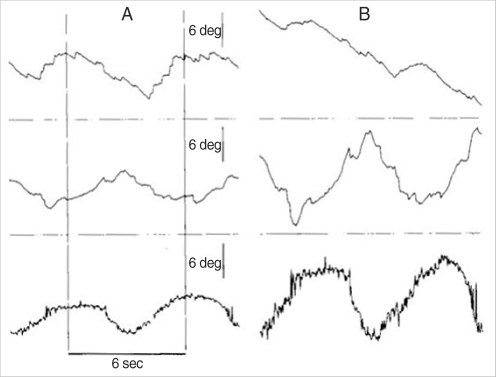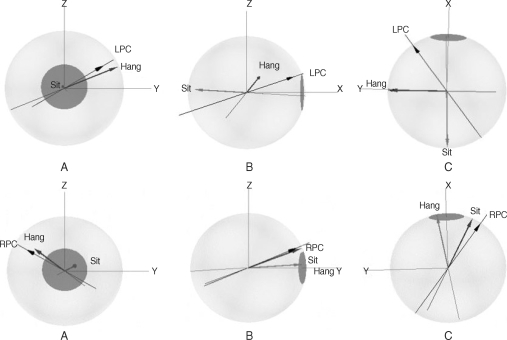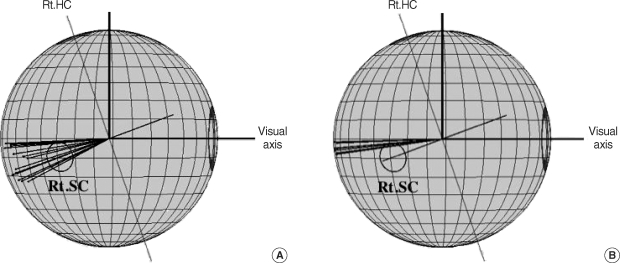Clin Exp Otorhinolaryngol.
2008 Jun;1(2):63-74. 10.3342/ceo.2008.1.2.63.
Nystagmus as a Sign of Labyrinthine Disorders: Three-Dimensional Analysis of Nystagmus
- Affiliations
-
- 1Department of Otolaryngology, Nippon Medical School, Tokyo, Japan. t.yagi@nms.ac.jp
- KMID: 1486056
- DOI: http://doi.org/10.3342/ceo.2008.1.2.63
Abstract
- In order to diagnose the pathological condition of vertiginous patients, a detailed observation of nystagmus in addition to examination of body equilibrium and other neurotological tests are essential. How to precisely record the eye movements is one of the goals of the researchers and clinicians who are interested in the analysis of eye movements for a long time. For considering that, one has to think about the optimal method for recording eye movements. In this review, the author introduced a new method, that is, an analysis of vestibular induced eye movements in three-dimensions and discussed the advantages and limitations of this method.
MeSH Terms
Figure
Reference
-
1. Baba S, Fukumoto A, Aoyagi M, Koizumi Y, Ikezono T, Yagi T. A comparative study on the observation of spontaneous nystagmus with Frenzel glasses and an infrared CCD camera. J Nippon Med Sch. 2004; 2. 71(1):25–29. PMID: 15129592.
Article2. Brandt HF. A bidimensional eye-movement camera. Am J Physiol. 1937; 10. 49(4):666–670.
Article3. Wendt Gr. Development of an eye camera for use with motion pictures. Psychol Monograph. 1952; 66(7):1–18.
Article4. Miller EF 2nd, Graybiel A. A comparison of ocular counter-rolling movements between normal persons and deaf subjects with bilateral labyrinthine defects. Ann Otol Rhinol Laryngol. 1963; 12. 72:885–893. PMID: 14088730.5. Kumar A, Glenn K. Binocular infrared oculography. Laryngoscope. 1992; 4. 102(4):367–378. PMID: 1556885.
Article6. Fender DH. Torsional movements of eye ball. Br J Ophthalmol. 1955; 2. 39(2):65–72. PMID: 14351667.7. Shackel B. Venables DH, Martin I, editors. Eye movement recording by electro-oculography. Manual of Psycho-physiological Methods. 1967. Amsterdam: North-Holland;p. 299–236.8. Gonshor A, Malcolm R. Effect of changes in illumination level on electro-oculography (EOG). Aerosp Med. 1971; 2. 42(2):138–140. PMID: 5547157.9. Robinson DA. A method of measuring of eye movements using scleral search coil in a magnetic field. IEEE Trans Biomed Eng. 1963; 10. 10:137–145. PMID: 14121113.10. Fuchs AF, Robinson DA. A method for measuring horizontal and vertical eye movements in the monkey. J Appl Physiol. 1966; 5. 21(3):1068–1070. PMID: 4958032.11. Collewjin H, van der Mark F, Jansen TC. Precise recording of human eye movements. Vision Res. 1975; 3. 15(3):447–450. PMID: 1136166.12. Otto D, Gehle F, Eckmiller R. Vide-oculographic measurement of 3-dimensional eye rotation. J Neurosci Methods. 1990; 12. 35(3):229–234. PMID: 2084392.13. Yamanobe S, Taira S, Morizono T, Yagi T, Kamio T. Eye movement analysis system using computerized image recognition. Arch Otolaryngol Head Neck Surg. 1990; 3. 116(3):338–341. PMID: 2306353.
Article14. Yagi T, Ohyama Y, Kamura E, Shitara A, Kokawa T, Abe S, Nishituji J. New three-dimensional analysis system of eye movements. Otolaryngol Head Neck Surg (Tokyo). 1998; 70(4):241–247.15. Scherer H, Teiwes W, Clarke AH. Measuring three dimensions of eye using dynamic situations by means of videooculography. Acta Otolaryngol. 1991; 111(2):182–187. PMID: 2068899.16. Yagi T, Koizumi Y, Aoyagi M, Kimura M, Sugizaki K. Three dimensional analysis of eye movements using four times high-speed video camera. Auris Nasus Larynx. 2005; 6. 32(2):107–112. PMID: 15917165.17. Uemura T, Cohen B. Effects of vestibular nuclei lesions on vetibulo-ocular reflexes and posture in monkeys. Acta Otolaryngol Suppl. 1973; 315:1–71. PMID: 4364922.18. Arai Y, Suzuki JI, Hess BJ, Henn V. Caloric nystagmus in three dimensions under otolith control in rhesus monkeys:A preliminary report. ORL J Otorhinolaryngol Relat Spec. 1990; 52(4):218–225. PMID: 2392284.19. Yagi T, Kurosaki S, Yamanobe S, Morizono T. Three-component analysis of caloric nystagmus in humans. Arch Otolaryngol Head Neck Surg. 1992; 10. 118(10):1077–1080. PMID: 1389059.
Article20. Suzuki K. [Three-dimensional analysis of vestibulo-ocular reflexes-the relation between head position and eye movement]. Nippon Jibiinkoka Gakkai Kaiho. 1996; 12. 99(12):1751–1757. Japanese. PMID: 8997093.21. Blanks RHI, Curthosy IS, Markham CH. Planar relationships of canals in man. Acta Otolaryngol. 1975; Sep–Oct. 80(3-4):185–196. PMID: 1101636.22. Feter M, Hain T, Zee DS. Influence of eye and head position on the vestibule-ocular reflex. Exp Brain Res. 1986; 64(1):208–216. PMID: 3770110.23. Guedry F Jr. Orientation of the rotation-axis relative to gravity. Acta Otolaryngol. 1965; Jul–Aug. 60:30–48. PMID: 14337956.24. Benson AJ, Bodin MA. Interaction of linear and angular acceleration on vestibular receptors in man. Aerosp Med. 1966; 2. 37(2):144–154. PMID: 5295433.25. Hess BJ, Dieringer N. Spatial organization of the maculo-ocular reflex of the rat:Responses during off-vertical axis rotation. Eur J Neurosci. 1990; 10. 2(11):909–919. PMID: 12106078.26. Darlot C, Lopez-Barneo J, Tracy D. Asymmetries of vertical vestibular nystagmus in the cat. Exp Brain Res. 1981; 2. 41(3-4):420–426. PMID: 7215503.
Article27. Harris LR. Vestibular and optokinetic eye movements evoked in the cat by rotation about a tilted axis. Exp Brain Res. 1987; 5. 66(3):522–532. PMID: 3609198.
Article28. Angelaki DA, Hess BJ. Three-dimensional organization of otolith-ocular reflexes in rhesus monkeys. J Neurophysiol. 1996; 6. 75(6):2405–2424. PMID: 8793753.29. Cohen B, Helwig D, Raphan T. Baclofen and velocity storage:a method of the effects of the drug on the vestibule-ocular reflex in the rhesus monkey. J Physiol. 1987; 12. 393:703–725. PMID: 3446808.30. Darlot C, Denise P, Droulez J, Cohen B, Berthoz A. Eye movements induced by off-vertical axis rotation (OVAR) at small angles of tilt. Exp Brain Res. 1988; 10. 73(1):91–105. PMID: 3208865.
Article31. Furman JMR, Schor RH, Schumann TL. Off-vertical axis rotation;a test of the otolith-ocular reflex. Ann Otol Rhinol Laryngol. 1992; 8. 101(8):643–650. PMID: 1497268.32. Yagi T, Kamura E, Shitara A. Three dimensional eye movement analysis during off vertical axis rotation in human subjects. Arch Ital Biol. 2000; 1. 138(1):39–47. PMID: 10604032.33. Kamura E, Yagi T. Three-dimensional analysis of eye movements during off vertical axis rotation in patients with unilateral labyrinthine loss. Acta Otolaryngol. 2001; 1. 121(2):225–228. PMID: 11349784.34. Goldberg JM, Fernandez C. Physiological mechanisms of the nystagmus produced by rotations about an earth horizontal axis. Ann N Y Acad Sci. 1981; 374:40–43. PMID: 6978636.35. Raphan T, Cohen C, Henn V. Effects of gravity on rotatory nystagmus in monkey. Ann N Y Acad Sci. 1981; 374:44–45. PMID: 6978641.36. Raphan T, Schnabolk C. Modeling slow phase velocity generation during off-vertical axis rotation. Ann N Y Acad Sci. 1988; 545:29–50. PMID: 3149166.37. Koizumi Y, Kimura M, Mokuno E, Yagi T. 3D eye movement analysis during sinusoidal off vertical axis rotation in human subjects. Acta Otolaryngol. 2003; 1. 123(2):121–128. PMID: 12701725.
Article38. Cohen B, Suzuki JI, Bender MB. Eye movements from semicircular canal nerve stimulation in the cat. Ann Otol Rhinol Laryngol. 1964; 3. 73:153–169. PMID: 14128701.39. Suzuki JI, Cohen B, Bender MB. Compensatory eye movements induced by vertical semicircular canal stimulation. Exp Neurol. 1964; 2. 9:137–160. PMID: 14126123.
Article40. Della Santina CC, Potyagaylo V, Migliaccio AA, Minor LB, Carey JP. Orientation of human semicircular canals measured by three-dimensional multiplanar CT reconstruction. J Assoc Res Otolaryngol. 2005; 9. 6(3):191–206. PMID: 16088383.
Article41. Yagi T, Kamura E, Shitara A. Three-dimensional analysis of pressure nystagmus in labyrinthine fistulae. Acta Otolaryngol. 1999; 3. 119(2):150–153. PMID: 10320065.42. McClure JA. Horizontal canal BPV. J Otolaryngol. 1985; 2. 14(1):30–35. PMID: 4068089.43. Pagnini P, Nuti D, Vannucchi P. Benign paroxysmal positional vertigo of the horizontal canal. ORL J Otorhinolaryngol Relat Spec. 1989; 51(3):161–170. PMID: 2734007.44. Baloh RW, Jacobson K, Honrubia V. Horizontal semicircular canal variant of benign positional vertigo. Neurology. 1993; 12. 43(12):2542–2549. PMID: 8255454.
Article45. Baloh RW, Richman L, Yee RD, Honrubia V. The dynamics of vertical eye movements in normal human subjects. Aviat Space Environ Med. 1983; 1. 54(1):32–38. PMID: 6830555.46. Yagi T, Morishita M, Koizumi Y, Kokawa M, Kamura E, Baba S. Is the pathology of horizontal canal benign paroxysmal positional vertigo really localize in the horizontal semicircular canal? Acta Otolaryngol. 2001; 12. 121(8):930–934. PMID: 11813897.47. Barany R. Diagnose von Krankhaitserscheinungen im Bereiche des Otolithenapparates. Acta Otolaryngol. 1921; 2:434–437.48. Dix MR, Hallpike CS. The pathology, symptomatology and diagnosis of certain common diseases of vestibular system. Proc R Soc Med. 1952; 45:341–354. PMID: 14941845.49. Schuknecht HF. Cupololithiasis. Arch Otolaryngol. 1969; 12. 90(6):765–778. PMID: 5353084.50. Hall SF, Ruby RRF, McClure JA. The mechanics of benign paroxysmal vertigo. J Otolaryngol. 1979; 4. 8(2):151–158. PMID: 430582.51. Fetter M, Sievering F. Three-dimensional eye movement analysis of benign paroxysmal positional vertigo and nystagmus. Acta Otolaryngol. 1995; 5. 115(3):353–357. PMID: 7653253.52. Aw ST, Todd MJ, Aw GE, McGarvie LA, Halmagi GM. Benign positional nysytagmus. A study of its three-dimensional spatio-temporal characteristics. Neurology. 2005; 6. 14. 64(11):1897–1905. PMID: 15955941.53. Yagi T, Koizumi Y, Kimura M, Aoyagi M. Pathological localization of so-called posterior canal BPPV. Auris Nasus Larynx. 2006; 12. 33(4):391–395. PMID: 16876361.
Article54. Minor LB, Solomon D, Zinreich JS, Zee D. Sound- and/or pressure-induced vertigo due to bone dehiscence of the superior semicircular canal. Arch Otolaryngol Head Neck Surg. 1998; 3. 124(3):249–258. PMID: 9525507.
Article55. Minor LB, Cremer PD, Carey JP, Dera Santina CC, Streubel SO, Weg N. Symptoms and signs in superior canal dehiscence syndrome. Ann N Y Acad Sci. 2001; 10. 942:259–273. PMID: 11710468.
Article56. Brantberg K, Bergenius J, Mendel L, Witt H, Tribukait A, Ygge J. Symptoms, findings and treatment in patients with dehiscence of the superior semicircular canal. Acta Otolaryngol. 2001; 1. 121(1):68–75. PMID: 11270498.57. Yagi T, Koizumi Y. 3D analysis of cough-induced nystagmus in a patient with superior semicircular canal dehiscence. Submitted.58. Uzun-Coruhlu H, Curthoys IS, Jones AS. Attachment of the utricular and saccular maculae to the temporal bone. Hear Res. 2007; 11. 233(1-2):77–85. PMID: 17919861.
Article59. Barany R. Uber die vom Ohrlabyrinth ausgeloste Gegenrollung der Augen bei Normalhorenden, Ohrenkranken und Taubstummen. Archiv fur Ohrenheilkunde. 1906; 68:1–30.60. Uchino Y, Sasaki M, Sato H, Imagawa H, Suwa H, Isu N. Utriculoocular reflex arc of the cat. J Neurophysiol. 1996; 9. 76(3):1896–1903. PMID: 8890302.
Article61. Uchino Y, Sasaki M, Sato H, Imagawa H, Suwa H, Isu N. Utricular input to cat extraocular motoneurons. Acta Otolaryngol Suppl. 1997; 528:44–48. PMID: 9288236.

